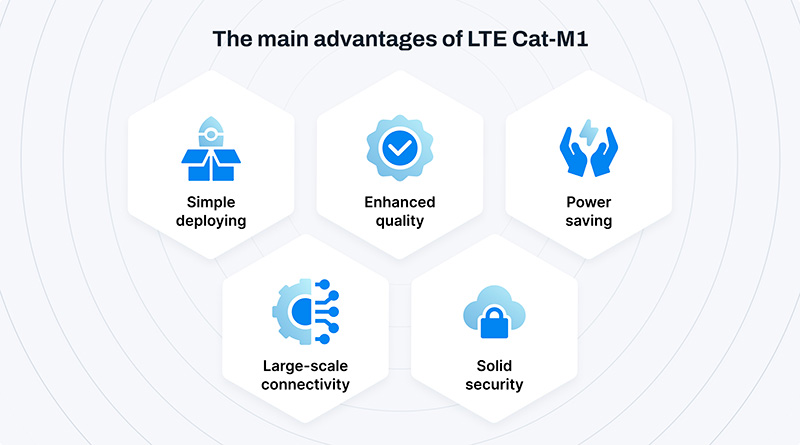Cat-M1: its relation to the IoT industry, advantages, and challenges
February 05, 2024Many IoT applications require devices that use minimal bandwidth and energy. Although 4G/LTE provides high-speed connectivity, it may consume too much power for certain IoT applications. This is where LTE Cat-M1 comes in, as it is a low-power variant of 4G/LTE that enables IoT devices to transmit small amounts of data infrequently. Unlike older cellular technologies, it offers faster connectivity and utilizes existing LTE infrastructure for quick deployment.
In the context of Industry 4.0, where reliability and cost efficiency are crucial, slower narrowband LTE options such as Cat-M1 are becoming more popular. This wireless technology provides a cost-effective alternative, consuming less power and bandwidth than faster options. As a result, devices can operate in remote areas with limited internet and power access, making Cat-M1 a scalable solution that can maintain project growth.
This article provides an overview of this technology's advantages and challenges to help you determine if it is suitable for your specific IoT application. Let's find out more about this fascinating technology.
What is LTE Cat-M1, and how does it work?
LTE Cat-M1 is a low-power, wide-area network designed for specialized devices like trackers and meters, transmitting moderate data over broad distances. It falls under 4G LTE technology for machines, offering up to 1Mbps download speeds. Operating on a low-frequency, narrow spectrum of 1.4 MHz. LTE Cat-M1 enhances connectivity range, which is ideal for numerous battery-operated devices with low data needs.
LTE Cat-M1 is advantageous for IoT due to its low power consumption, reduced data costs, and improved efficiency. Its power-saving mode, activated during inactivity, prolongs the device's battery life, minimizing the need for frequent replacements in extensive IoT deployments.
Moreover, Cat-M1 operates in a licensed spectrum, enhancing security for sensitive data and making it suitable for applications like military operations or law enforcement processes. Overall, Cat-M1 is a compelling choice for IoT scenarios with modest data needs, offering reduced battery consumption and enhanced privacy.
Cat-M1 offers competitive pricing compared to other providers thanks to its use of LTE connectivity, eliminating the need for additional antennas and equipment. Moreover, its low power consumption significantly reduces maintenance costs when compared to alternatives like 3G and satellite connectivity.
Cat-M1 connection to IoT
The market for IoT devices is expanding rapidly, and the use of cellular-connected devices is also increasing. The main advantage of using cellular networks is their constant connectivity, which is suitable for connecting devices in areas without internet or Wi-Fi access, providing a reliable option in case of internet failure.
For small edge devices that transmit low amounts of data, speed is less important than operating costs. Waiting for web pages to load may be frustrating for us in our daily lives. Technologies like Cat-M1 excel in the Industrial IoT realm, where data needs differ from common 4G or 5G usage. Lower power, bandwidth, and cost options are essential for fostering the growth of connected technology in this context.
LTE Cat-M1 advantages

Simple deploying
Deploying LTE Cat-M1 is convenient as it works with existing networks, making it simpler than NB-IoT. Devices equipped with IoT SIMs can be connected by merely turning them on, requiring no additional infrastructure. However, it's essential to note that not all carriers globally have implemented the necessary software changes to fully support Cat-M1 deployments.
Enhanced -quality
LTE-M networks, managed by mobile network operators, regulate device numbers, ensuring consistent connectivity quality. These networks utilize low-frequency spectrum bands, providing extensive coverage across larger areas.
Power saving
LTE-M technology provides power-saving capabilities such as power-saving mode (PSM) and extended discontinuous reception (eDRX), which allow IoT devices to conserve their battery life. PSM puts the device into sleep mode when there is no activity, while eDRX allows longer sleep durations with periodic wake-ups. By configuring these features correctly, batteries can last for months or even longer in LTE-M-powered IoT ecosystems.
Large-scale connectivity
LTE-M devices operating on a low-frequency spectrum enable more devices to connect to the network, making it an ideal choice for massive IoT. With LTE-M, you can have more devices operating on one cell than is possible with traditional 4G/LTE.
Solid security
LTE-M ensures a secure connection to the cloud through carrier-controlled licensed spectrum. Each device's unique SIM card provides a distinct identifier for secure access to the network.
LTE Cat-M1 challenges
Platforms management
If your IoT devices move across regions, they might need multiple carriers for roaming. Handling multiple carriers and managing numerous devices within a massive IoT setup can be complex.
Lower speed
LTE-M doesn't match the speed of regular 4G networks, but that's intentional for specific IoT applications. In these cases, prioritizing power efficiency and coverage over speed and bandwidth makes LTE-M a suitable choice.
Limited coverage
LTE-M offers extensive coverage in the USA. However, global LTE-M deployment is limited, requiring devices to have a SIM card and modem with 3G fallback for worldwide connectivity.
Conclusion
In conclusion, LTE Cat-M1 stands out as a pivotal technology for the Internet of Things. Its low-power, wide-area network design, cost efficiency, and compatibility with existing networks make it a compelling choice for IoT applications because it has benefits like extended battery life, security features, and ease of deployment. LTE Cat-M1 is a strategic solution for various industries, driving the evolution of connected devices and contributing to the growth of the IoT ecosystem.
Moreover, the cost advantages, competitive pricing, and potential for global connectivity boost LTE Cat-M1's appeal. As industries embrace the benefits of this technology, it not only addresses connectivity challenges but also fosters innovation by enabling IoT deployments in remote locations. LTE Cat-M1 not only meets the current demands of Industry 4.0 but also paves the way for a connected future, where efficiency, reliability, and scalability are paramount.


